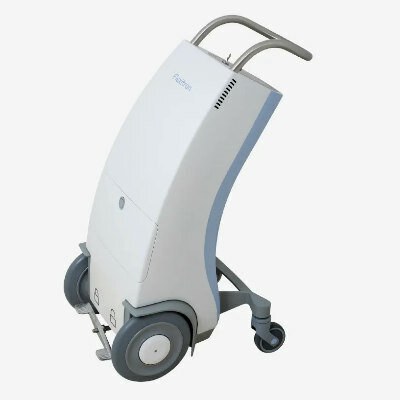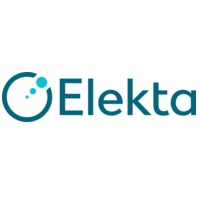In-Office Solution Provides Direct Arthroscopic Imaging
|
By MedImaging International staff writers Posted on 27 Mar 2018 |

Image: The Mi-Eye 2 handheld visualization device and dedicated HD tablet (Photo courtesy of Trice Medical).
A novel handheld tool provides illumination and visualization of interior cavities of the body through either a natural or surgical opening.
The Trice Medical (Malvern, PA, USA) Mi-Eye 2 is a single-use, disposable arthroscope that consists of a needle with an integrated camera and light source that allows surgeons to perform a full diagnostic arthroscopic or endoscopic procedure as an alternative to traditional diagnostic modalities, such as time-consuming magnetic resonance imaging (MRI). Features of the Mi-Eye 2 device include a 120° field of view, a 5-35mm depth of field, real-time image and video capture, and integrated optic and light source. The images are viewed on a dedicated high definition (HD) tablet device with a 10.8” display powered by a 1.6GHz Intel atom processor.
The heart of the system is a retractable 2.2 mm needle percutaneously inserted into the joint space, with the joint numbed prior to the procedure using local anesthesia. Once inside the joint space, the needle retracts to expose the Mi-Eye 2 camera and light source; once retracted, the needle is blunted by the camera. The surgeon can then perform a diagnostic arthroscopy exam to detect pathology in the intra-articular space. A 19-gauge lumen is available to inject or aspirate fluid during the procedure. At the conclusion of the procedure, the entirety of the Mi-Eye 2 is thrown into a sharps container.
“MRI and Ultrasound will always be good options for patients with sports injuries. We are thrilled to add disposable in-clinic arthroscopy to the list of available tools physicians have to be able to assess joint injuries,” said Mark Foster, chief commercialization officer and VP of worldwide sales at Trice Medical. “In many countries, the Mi-Eye 2 has a chance to save weeks to months of the treatment pathway to surgery and provide a dynamic image of the joint.”
“The Mi-Eye 2 offers results better than those of traditional MRI scans for diagnosing certain conditions; it provides an eye inside the body. The advantage of the technology is that it takes places in a setting convenient for the patient. They find out their results right on the spot,” said orthopedic surgeon John Corsetti, MD, of New England Orthopedic Surgeons (NEOS; Springfield, MA, USA). “Patient satisfaction has been extremely high with this new technology. They are pleased that they get to work with me while they are awake so they can ask me any questions about what they see on the screen.”
Related Links:
Trice Medical
The Trice Medical (Malvern, PA, USA) Mi-Eye 2 is a single-use, disposable arthroscope that consists of a needle with an integrated camera and light source that allows surgeons to perform a full diagnostic arthroscopic or endoscopic procedure as an alternative to traditional diagnostic modalities, such as time-consuming magnetic resonance imaging (MRI). Features of the Mi-Eye 2 device include a 120° field of view, a 5-35mm depth of field, real-time image and video capture, and integrated optic and light source. The images are viewed on a dedicated high definition (HD) tablet device with a 10.8” display powered by a 1.6GHz Intel atom processor.
The heart of the system is a retractable 2.2 mm needle percutaneously inserted into the joint space, with the joint numbed prior to the procedure using local anesthesia. Once inside the joint space, the needle retracts to expose the Mi-Eye 2 camera and light source; once retracted, the needle is blunted by the camera. The surgeon can then perform a diagnostic arthroscopy exam to detect pathology in the intra-articular space. A 19-gauge lumen is available to inject or aspirate fluid during the procedure. At the conclusion of the procedure, the entirety of the Mi-Eye 2 is thrown into a sharps container.
“MRI and Ultrasound will always be good options for patients with sports injuries. We are thrilled to add disposable in-clinic arthroscopy to the list of available tools physicians have to be able to assess joint injuries,” said Mark Foster, chief commercialization officer and VP of worldwide sales at Trice Medical. “In many countries, the Mi-Eye 2 has a chance to save weeks to months of the treatment pathway to surgery and provide a dynamic image of the joint.”
“The Mi-Eye 2 offers results better than those of traditional MRI scans for diagnosing certain conditions; it provides an eye inside the body. The advantage of the technology is that it takes places in a setting convenient for the patient. They find out their results right on the spot,” said orthopedic surgeon John Corsetti, MD, of New England Orthopedic Surgeons (NEOS; Springfield, MA, USA). “Patient satisfaction has been extremely high with this new technology. They are pleased that they get to work with me while they are awake so they can ask me any questions about what they see on the screen.”
Related Links:
Trice Medical
Latest General/Advanced Imaging News
- New AI Method Captures Uncertainty in Medical Images
- CT Coronary Angiography Reduces Need for Invasive Tests to Diagnose Coronary Artery Disease
- Novel Blood Test Could Reduce Need for PET Imaging of Patients with Alzheimer’s
- CT-Based Deep Learning Algorithm Accurately Differentiates Benign From Malignant Vertebral Fractures
- Minimally Invasive Procedure Could Help Patients Avoid Thyroid Surgery
- Self-Driving Mobile C-Arm Reduces Imaging Time during Surgery
- AR Application Turns Medical Scans Into Holograms for Assistance in Surgical Planning
- Imaging Technology Provides Ground-Breaking New Approach for Diagnosing and Treating Bowel Cancer
- CT Coronary Calcium Scoring Predicts Heart Attacks and Strokes
- AI Model Detects 90% of Lymphatic Cancer Cases from PET and CT Images
- Breakthrough Technology Revolutionizes Breast Imaging
- State-Of-The-Art System Enhances Accuracy of Image-Guided Diagnostic and Interventional Procedures
- Catheter-Based Device with New Cardiovascular Imaging Approach Offers Unprecedented View of Dangerous Plaques
- AI Model Draws Maps to Accurately Identify Tumors and Diseases in Medical Images
- AI-Enabled CT System Provides More Accurate and Reliable Imaging Results
- Routine Chest CT Exams Can Identify Patients at Risk for Cardiovascular Disease
Channels
Radiography
view channel
Novel Breast Imaging System Proves As Effective As Mammography
Breast cancer remains the most frequently diagnosed cancer among women. It is projected that one in eight women will be diagnosed with breast cancer during her lifetime, and one in 42 women who turn 50... Read more
AI Assistance Improves Breast-Cancer Screening by Reducing False Positives
Radiologists typically detect one case of cancer for every 200 mammograms reviewed. However, these evaluations often result in false positives, leading to unnecessary patient recalls for additional testing,... Read moreMRI
view channel
PET/MRI Improves Diagnostic Accuracy for Prostate Cancer Patients
The Prostate Imaging Reporting and Data System (PI-RADS) is a five-point scale to assess potential prostate cancer in MR images. PI-RADS category 3 which offers an unclear suggestion of clinically significant... Read more
Next Generation MR-Guided Focused Ultrasound Ushers In Future of Incisionless Neurosurgery
Essential tremor, often called familial, idiopathic, or benign tremor, leads to uncontrollable shaking that significantly affects a person’s life. When traditional medications do not alleviate symptoms,... Read more
Two-Part MRI Scan Detects Prostate Cancer More Quickly without Compromising Diagnostic Quality
Prostate cancer ranks as the most prevalent cancer among men. Over the last decade, the introduction of MRI scans has significantly transformed the diagnosis process, marking the most substantial advancement... Read moreUltrasound
view channel
Deep Learning Advances Super-Resolution Ultrasound Imaging
Ultrasound localization microscopy (ULM) is an advanced imaging technique that offers high-resolution visualization of microvascular structures. It employs microbubbles, FDA-approved contrast agents, injected... Read more
Novel Ultrasound-Launched Targeted Nanoparticle Eliminates Biofilm and Bacterial Infection
Biofilms, formed by bacteria aggregating into dense communities for protection against harsh environmental conditions, are a significant contributor to various infectious diseases. Biofilms frequently... Read moreNuclear Medicine
view channel
New SPECT/CT Technique Could Change Imaging Practices and Increase Patient Access
The development of lead-212 (212Pb)-PSMA–based targeted alpha therapy (TAT) is garnering significant interest in treating patients with metastatic castration-resistant prostate cancer. The imaging of 212Pb,... Read moreNew Radiotheranostic System Detects and Treats Ovarian Cancer Noninvasively
Ovarian cancer is the most lethal gynecological cancer, with less than a 30% five-year survival rate for those diagnosed in late stages. Despite surgery and platinum-based chemotherapy being the standard... Read more
AI System Automatically and Reliably Detects Cardiac Amyloidosis Using Scintigraphy Imaging
Cardiac amyloidosis, a condition characterized by the buildup of abnormal protein deposits (amyloids) in the heart muscle, severely affects heart function and can lead to heart failure or death without... Read moreImaging IT
view channel
New Google Cloud Medical Imaging Suite Makes Imaging Healthcare Data More Accessible
Medical imaging is a critical tool used to diagnose patients, and there are billions of medical images scanned globally each year. Imaging data accounts for about 90% of all healthcare data1 and, until... Read more
Global AI in Medical Diagnostics Market to Be Driven by Demand for Image Recognition in Radiology
The global artificial intelligence (AI) in medical diagnostics market is expanding with early disease detection being one of its key applications and image recognition becoming a compelling consumer proposition... Read moreIndustry News
view channel
Bayer and Google Partner on New AI Product for Radiologists
Medical imaging data comprises around 90% of all healthcare data, and it is a highly complex and rich clinical data modality and serves as a vital tool for diagnosing patients. Each year, billions of medical... Read more





















